Posted: January 5th, 2015 | 1 Comment »
Shortly before the end of last year I blogged on Pondicherry in the former French controlled part of India and preservation issues. Thanks to everyone for comments – however it appears that things are far worse than I suspected – basically the former Hotel de Ville is not simply damaged but basically destroyed, as the photos below taken this week indicate clearly.
To paraphrase some current visitors and those more familiar with the city than me it seems that while Pondicherry is a truly remarkable place, and its French architectural legacy is genuinely special, just how it garnered any accolade for “heritage preservation” is mystifying. Of course anyone who has seen how easily UNESCO hand out awards in China and then fail to do any follow up or apply any sanction on post-award destruction, will be familiar with this!! This has been a global UNESCO failing for many years now. Pondicherry, it seems to be agreed, does have a handful of truly beautiful old buildings, but they are decayed, closed and rotting in the hot sun. Several have been smashed down completely. Those that have been renovated have been done so with an unnecessarily heavy hand. “Preservation” is not the correct word, as they have been restyled with little regard to the original architectural nuances – windows and door frames have been replaced with cheap copies and the entire facades have been slathered in a thick layer of new concrete and then painted in garish colours.
Oh well…but for the record here’s the Hotel de Ville….
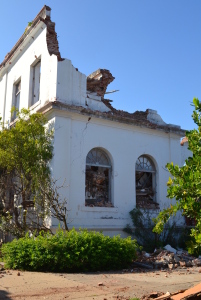
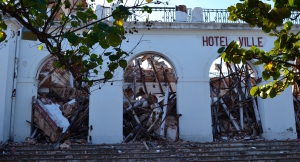
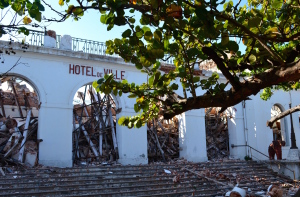
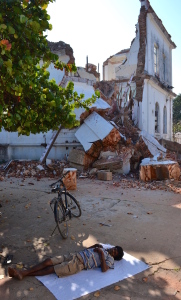
Posted: January 4th, 2015 | No Comments »
I came across a couple of references recently to the Rokusan Gardens in Shanghai, a park who’s existence I was not previously aware of. The Rokusan Gardens were laid out in 1896 at the north end of North Szechuan Road (Sichuan Road North nowadays) which was itself laid out and planned in the late 1860s. The North Szechuan Road was a popular gathering place for the International Settlement’s Japanese community, it was home to the small Uchiyama Shoten bookshop owned by the Japanese intellectual Kanza Uchiyama, which was where Lu Xun often bought books. Also the nearby Gongfei Coffee Shop on the second floor of a North Szechuan Road building was a salon where Chinese and Japanese writers and intellectuals met to discuss literature and the arts before the second world war. I am assuming the Gardens were at the northern end of the road and probably just outside the official Settlement borders in Chapei (Zhabei). The Gardens were small as they don’t appear on many maps. The Gardens apparently included a small Japanese Shinto shrine surrounded by a small artificial pond and flowering shrubs. There was also a small Japanese-style tea house within the grounds.
the Gardens were also adjacent to a Japanese restaurant, also called Rokusan,which was the most popular Japanese restaurant with westerners in Shanghai (and opened in 1912 I think) until it was destroyed in the Shanghai War of 1932 and never rebuilt. In 1932 the Gardens were the scene of fierce fighting when Chinese shock troops arrived from Canton (Guangzhou) pinned down elements of the second and fifth battalions of the Japanese Marines in the Gardens and a significant fire fight occurred – enough to be reported in American newspapers. I believe the Rokusan Restaurant closed after 1932 though the building remained and is the one on North Sichuan Road below – though far from sure I’ve got this right!!
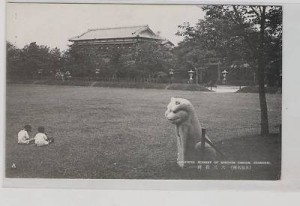 The Rokusan Gardens shortly before it was devastated in the Shanghai War of 1932
The Rokusan Gardens shortly before it was devastated in the Shanghai War of 1932
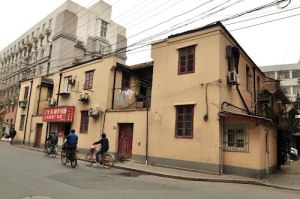
The former Rokusan Restaurant buidling – the ugly modern block to the left is on the site of the former Rokusan Gardens (I think…)
Posted: January 3rd, 2015 | 1 Comment »
So the cast assembled for the Downton Abbey Christmas Special 2014 – there they all were at Brancaster Castle for the holidays, the young folk of Downton – Lady Mary, Lady Rose, Lady Edith and some new blokes who look quite promising. On went the new gramaphone (well, it is 1924) and what should they dance to but an oriental fox trot.
Now Oriental Fox trots are a now largely forgotten musical genre from the 1920s that combined the infamous “plinky plonk’ sound supposedly reminiscent of Chinese music with the new vogue for ragtime and the fox-trot. I’ve blogged about the fad for Oriental Fox Trots before (specifically 1928’s Sing Song Girl of Old Shanghai) and they do date back to the early 1900s – there are references to Vincent Rose’s Oriental Fox Trot (see below) from 1905 onwards through to the early 1930s.
Here are a few examples of Oriental Fox Trots below – but does anyone know which one they played on Downton??? I’ll think of a prize if anyone can tell me????
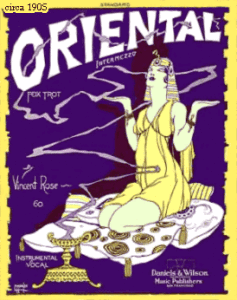 1905
1905
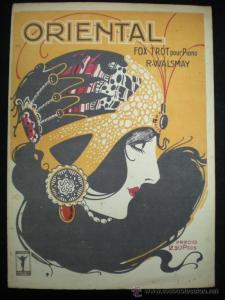
Not sure of the date on this one….

More near east than far east but still…1920
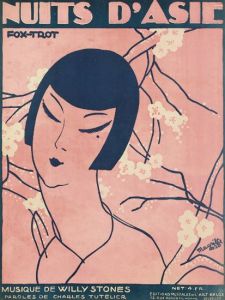
1925 – cover art by Rene Magritte no less….
Posted: January 2nd, 2015 | No Comments »
Jonathan Goldstein’s Jewish Identities in East Asia is a tad pricey, so probably a trip to the college library is involved….
 The Jewish communities of East and Southeast Asia display an impressive diversity. Jonathan Goldstein book focuses on transnational Jewish identity in seven of this area’s largest cities and trading emporia: Singapore, Manila, Taipei, Harbin, Shanghai, Rangoon, and Surabaya. What was the source of this enduring identity, which included strong elements of Russian, Chinese, Japanese, but also specifically Jewish culture? What had preserved the Jewish identity under such excruciating circumstances? The book covers the period 1750 up to the present and emphasizes five factors which influenced the formation of Jewish transnational identity in these places: memory, colonialism, regional nationalism, socialism, and Zionism.
The Jewish communities of East and Southeast Asia display an impressive diversity. Jonathan Goldstein book focuses on transnational Jewish identity in seven of this area’s largest cities and trading emporia: Singapore, Manila, Taipei, Harbin, Shanghai, Rangoon, and Surabaya. What was the source of this enduring identity, which included strong elements of Russian, Chinese, Japanese, but also specifically Jewish culture? What had preserved the Jewish identity under such excruciating circumstances? The book covers the period 1750 up to the present and emphasizes five factors which influenced the formation of Jewish transnational identity in these places: memory, colonialism, regional nationalism, socialism, and Zionism.
Posted: January 1st, 2015 | No Comments »

Membership Recruitment Letter
Dear Members and Friends,
The Beijing Chapter of the Royal Asiatic Society China was launched over a year ago, with the aim of uniting Chinese and expats in appreciation and study of China’s history, culture, thought and current affairs. We’ve held a number of memorable events over the past year. Some highlights:
— A weekend spent at Bailin temple, a working Buddhist monastery in Hebei. We learned about the life and beliefs of the resident monks, attended prayer sessions, and wandered the halls and courtyards of this historic temple in the quiet of the evening.
— A discussion on business ethics between leading experts who compared and contrasted Eastern and Western perspectives.
— A walking tour of the Yuanmingyuan, the old Summer Palace. Our guide was a leading expert on the topic, who brought this iconic site to life with little-known facts and firsthand accounts related to the history of the Yuanmingyuan and its role in Chinese imperial society.
— A day trip to to the ancient village of Moshikou which, despite the onslaught of modern buildings, features a well-preserved necropolis dedicated to imperial eunuchs, as well as the Fahai Temple with extraordinary Buddhist murals dating back to the 15th century; our guide was one of Beijing’s foremost specialists on cultural preservation work.
To build on the achievements of the past year, RASBJ needs your continuing support! For those who haven’t renewed membership yet, please do so to enjoy membership benefits without interruption. For those who aren’t members yet, please join now — you’ll receive priority access to upcoming events, a copy of the journal, and invitations to members-only activities.
RASBJ has more unique offerings coming up — among them a Dec.16 showing of the documentary film “Last Train Home”; the Annual General Meeting for RASBJ members on Dec. 17; and in early 2015 an unusual look at Chinese and Western experiences during the Boxer Rebellion as well as a return visit to the Old Summer Palace for a peek at the “virtual Yuanmingyuan” project.
Starting with the 2015 membership year, the RASBJ’s one-year memberships/renewals will be divided into quarters, beginning the first of January, April, July and October. This means your annual membership is valid for at least one full year, from the date on which you joined until the end of the relevant quarter of the following year. If you joined RASBJ in May 2014, you’ll be asked to renew by June 1, 2015. If you joined in 2013, on any date, you are being asked to renew before January 1, 2015.
      Â
For more information visit www.rasbj.org or e-mail membership@rasbj.org. Thanks for your support!
The Royal Asiatic Society China, Beijing Chapter
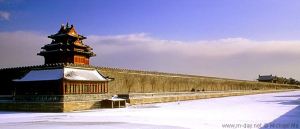
Posted: January 1st, 2015 | No Comments »
As usual it was not a great year for architectural preservation in Asia – Beijing and Shanghai carried on pulling down perfectly restorable buildings to create car parks and shopping centres and this is the year we can add Burma to the list of devastation cities – Rangoon’s colonial architecture looks to be (I think it’s fair to say) in grave peril. We had a few wins in places like Bombay and Taipei but a few losses in places like Pondicherry and Keelung and plenty of “uncerrtains” across the region from Manila to Kashgar.
But here’s some good news – I blogged recently on plans to destroy the old Grands Magasins Charner department store building in Saigon, a fine relic of French colonial architecture. Despite the usual coalition of property developers and the communist party wanting to destroy the building (with the usual slogans of progress, profit, leaving the past behind etc etc) there was a pretty decent public campaign to save at least part of the building.
And so it has been announced that the Ho Chi Minh City mayor’s office has approved a proposal to preserve parts of the Saigon Tax Trade Centre that had slated to be torn down to make way for a 40-story skyscraper.According to the proposal, made by the city’s architecture department, the developer of the new building is to preserve the main lobby, the grand staircase and bronze railings as well as the tiled lobby mosaic. As for the building’s exterior, the developer will have to preserve the ornate overhangs that shade the sidewalks.There’s more details here from the Vietnamese newspapers…but I’m calling this a victory for preservation at the end of 2014 and a hopefully good sign for 2015….
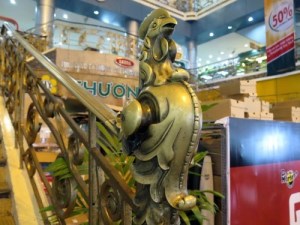
A banister contour at the Saigon Tax Trade Center carved in the shape of the Coq Gaulois (the Gallic Rooster).
Posted: December 31st, 2014 | No Comments »
Oh, if there was ever a new year’s eve night out to be had!! Strangely, I didn’t know Marlene Dietrich, of Shanghai Express fame (at least on this blog which has done any number of posts on Dietrich as Shanghai Lily!!), gave concerts in Tokyo – but she did in 1974…and here’s the playbill…..

Posted: December 30th, 2014 | No Comments »
Peter Peverelli’s memoir of his year in China, One Turbulent Year, is a fascinating read. Of course ex-pat memoirs (Carl Crow, JB Powell, Hallett Abend, Frances Wood and a few others excepted) are not normally noteworthy, but it was 1975! Peverelli has posted excerpts from the book on his blog too…
















